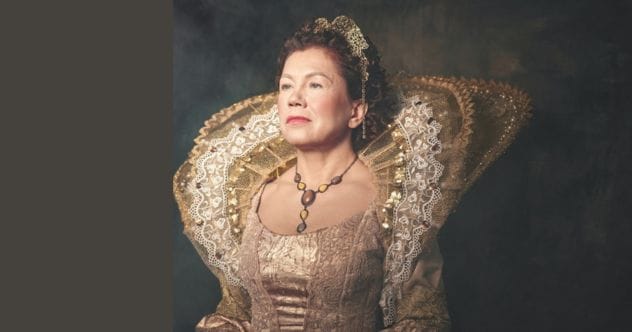What comes to mind when you hear the word “influencer”? Maybe you picture someone on Instagram showing off clothes, or a TikTok user trying to get you to buy something. Influencers have become a huge part of the online world. It seems like everywhere you look, someone is trying to persuade you to buy or try something. But influencers existed long before social media and the internet!
Let’s explore ten historical figures who were trendy, highly visible, and widely copied. These men and women from centuries ago were the original influencers. Imagine what Instagram and TikTok would have been like if they had accounts!
10. Queen Elizabeth I
Smallpox was a serious problem in 16th-century Europe, even for royal families. In 1562, Queen Elizabeth I of England caught smallpox and almost died. Although she survived, the disease left scars on her face and body. As a queen, she needed to look beautiful and regal. So, she started a trend of using makeup to hide blemishes.
Queen Elizabeth created a white paste made of lead and vinegar, which she applied to her face. At first, she used it to cover her scars, but soon, others began to copy her. As England’s most visible woman, she was always under scrutiny. Because she was so well-known, many women started using makeup like her. This trend spread across different social classes, with a perfectly white face becoming a symbol of youth and wealth. Today, the makeup industry is massive, and it all started with a queen covering up smallpox scars.
9. Giuseppe Garibaldi
Giuseppe Garibaldi is famous for fighting for the unification of Italy. As a general in the mid-19th century, he played a key role in making Italy a kingdom. But his influence didn’t stop there. Garibaldi also influenced fashion!
Garibaldi led a small army that wore baggy red shirts instead of uniforms because they didn’t have any. People admired Garibaldi’s bravery and devotion to his cause. As a result, they also loved the red shirts his men wore.
In support, women in Italy started wearing red shirts daily. These shirts were fashionable because they represented Garibaldi’s cause. They were also practical, easy to wear, and suitable for work. The “Garibaldi shirt” became iconic throughout Italy. Decades later, it appeared in ladies’ fashion magazines and eventually became the blouse, a common item in women’s wardrobes. Who knew a military man could have such an impact on fashion?
8. Madame Wellington Koo
Oei Hui-lan, known as Madame Wellington Koo, was the first lady of the Republic of China from 1926 to 1927. She made a significant mark on history by bringing Chinese fashion to the forefront when the rest of the world largely ignored it.
Madame Koo’s most lasting fashion choice was popularizing the “qipao,” also known as the “cheongsam.” This traditional Chinese garment was a robe-like dress with intricate designs, historically worn only by the upper classes. Madame Koo reimagined the qipao as a figure-hugging dress with a side slit, making it even more fashionable.
Her modern take on the traditional dress was well-received by women in China and around the world. Although her time as a political figure was brief, the qipao had a lasting impact on Chinese fashion. Women began to copy her style, and her influence was felt throughout the early 20th century.
7. Morris Frank
Morris Frank, born into a wealthy family in Tennessee, lost an eye at age six in a horseback riding accident. Ten years later, he lost sight in his other eye. Suddenly blind as a teenager, he needed help.
In 1927, Frank learned about Dorothy Eustis, who trained German Shepherds to guide blind war veterans in the UK. Intrigued, Frank contacted Eustis, wanting to start a similar program in the United States. And so, history was made.
After training with Eustis, Frank trained a guide dog. He lived his daily life publicly, amazing people with his independence. This blind man could do everything “normal” people could! Frank’s story of using a seeing-eye dog—the first one specifically trained for this purpose in the US—became hugely influential. Under his guidance, the Seeing Eye organization started in the US, providing canine assistance to blind people nationwide.
6. Queen Victoria
Queen Victoria’s wedding was so iconic that it created an entirely new wedding trend. In 1840, she wore a white, off-the-shoulder lace dress. Although it wasn’t the first white wedding dress, it was the most high-profile.
The publicity from her wedding made white wedding dresses the new standard for brides of all social classes. Descriptions of the dress circulated in newspapers, captivating women who wanted to copy Victoria’s look.
The fashion industry adapted, with synthetic fibers enabling mass production of clothing and wedding dresses. Soon, women from all walks of life could wear white wedding dresses on their big day. Queen Victoria became a fashion icon, and the wedding industry has never been the same since.
5. William Dorsey Swann
In 1888, William Dorsey Swann hosted a drag queen ball in Washington, D.C. These secret balls were attended by Black men dressed in women’s gowns. During one event, police infiltrated the ball. While many fled, Swann stayed and was arrested. Newspapers called him the “Queen” of the event, and the term “drag queen” took hold.
Swann’s life was one of transgression. His willingness to be arrested for his drag queen events made him one of the first LGBT resistance fighters. He was the first person to openly call himself a drag queen.
He continued to host balls with singing and dancing, showing no shame in who he was. Swann was one of the earliest LGBT influencers. His actions significantly impacted gay culture for decades.
4. Emiliano Zapata
Mustaches have been around for a long time, but Emiliano Zapata, the famous Mexican revolutionary leader, rocked a mustache like no other! In the early 20th century, Zapata fought for the rights of peasants in the Mexican Revolution, sporting an extremely bushy mustache. Because he was so popular among the poor, his entire persona was widely copied and revered.
Many Mexicans who wanted to support his cause began mimicking his mustache. Zapata’s decision to always wear his mustache, expertly groomed, meant that it became closely tied to the revolution itself.
In just a few years, his mustache became a sign of Mexican patriotism. The thick mustache, curved downward, was associated with Zapata and the fight for peasants’ rights. It was an early meme before the internet even existed!
3. Amelia Bloomer
In 1848, women across the United States sought greater participation in government. The Seneca Falls Convention gave women a voice and sought more political influence. Amelia Bloomer, an attendee, stood out.
Bloomer helped create “The Lily,” a newspaper focused on women’s rights and temperance. However, it was Bloomer’s fashion choice that was truly influential. She believed that corsets and tight-fitting dresses were too restrictive.
She created comfortable, full-cut pantaloons to wear under a skirt. Other women had worn similar garments, but Bloomer perfected the design. Her high-profile status from the Seneca Falls Convention and “The Lily” made her name synonymous with the garment. The pantaloons quickly became known as “bloomers,” and the style spread across America.
2. King Louis XIV
Wigs had been used throughout history, but King Louis XIV made them stylish in the mid-17th century. His father, King Louis XIII, started the trend by wearing a wig to cover his baldness in the 1620s. However, Louis XIV’s own luscious hair made wigs even more fashionable after he took the throne in 1643.
Louis XIV had thick, black hair that set a new beauty standard for royalty across Europe. Royals and aristocrats envied his hair. Because many didn’t have such thick locks or were already balding, wigs became the fashion move for high-class men.
Courtiers in France and Europe began wearing wigs to follow the trend set by Louis XIV. King Charles II of Great Britain and Ireland also wore a wig to hide his graying hair in 1663. Ironically, by 1673, Louis XIV’s hair had begun to thin, so he added false hair to keep up appearances. The (accidental) influencer got caught up in his own influence, and so did everyone else!
1. Ambrose Burnside
Ambrose Burnside was a Union General during the American Civil War, the governor of Rhode Island, and a United States Senator. But he is remembered for one thing: the creation of sideburns. They are even named after him!
While Burnside wasn’t the first to wear sideburns, his were so exquisite and bushy that they were hard to ignore. He had been forced to maintain a clean-cut appearance as a cadet at West Point and hated it. As he got older, he grew out the hair on the sides of his face and got creative with it.
Because Burnside was a military hero and a public figure, people took interest in his sideburns. They were undeniably full and thick, capturing the public’s attention. The rise of photography helped spread his image further. His name was used to create a term for the look. Originally known as “burnsides,” the words were flipped, and now we have sideburns!
Which of these influencers surprised you the most? Leave your comment below!










